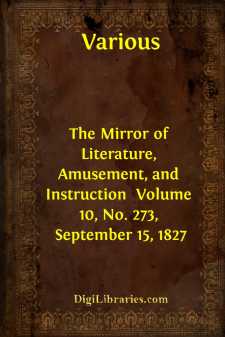Categories
- Antiques & Collectibles 13
- Architecture 36
- Art 48
- Bibles 22
- Biography & Autobiography 813
- Body, Mind & Spirit 142
- Business & Economics 28
- Children's Books 17
- Children's Fiction 14
- Computers 4
- Cooking 94
- Crafts & Hobbies 4
- Drama 346
- Education 46
- Family & Relationships 57
- Fiction 11829
- Games 19
- Gardening 17
- Health & Fitness 34
- History 1377
- House & Home 1
- Humor 147
- Juvenile Fiction 1873
- Juvenile Nonfiction 202
- Language Arts & Disciplines 88
- Law 16
- Literary Collections 686
- Literary Criticism 179
- Mathematics 13
- Medical 41
- Music 40
- Nature 179
- Non-Classifiable 1768
- Performing Arts 7
- Periodicals 1453
- Philosophy 64
- Photography 2
- Poetry 896
- Political Science 203
- Psychology 42
- Reference 154
- Religion 513
- Science 126
- Self-Help 84
- Social Science 81
- Sports & Recreation 34
- Study Aids 3
- Technology & Engineering 59
- Transportation 23
- Travel 463
- True Crime 29
The Mirror of Literature, Amusement, and Instruction Volume 10, No. 273, September 15, 1827
by: Various
Categories:
Description:
Excerpt
GASPARD MONGE'S MAUSOLEUM.
(To the Editor of the Mirror.)
Sir,—As one of your correspondents has favoured you with a drawing of the gaol I designed for the city and county of Norwich, with which you have embellished a recent number of the MIRROR, I flatter myself that an engraving from the drawing I herewith send you of the mausoleum of Gaspard Monge, which I drew while at Paris, in 1822, will also be interesting to the readers of your valuable little miscellany. Gaspard Monge, whose remains are deposited in the burying ground in Pere la Chaise, at Paris, in a magnificent mausoleum, was professor of geometry in the Polytechnique School at Paris, and with Denon accompanied Napoleon Bonaparte on his memorable expedition to Egypt; one to make drawings of the architectural antiquities and sculpture, and the other the geographical delineations of that ancient country. He returned to Paris, where he assisted Denon in the publication of his antiquities. At his decease the pupils of the Polytechnique School erected this mausoleum to his memory, as a testimony of their esteem, after a design made by his friend, Monsieur Denon. The mausoleum is of Egyptian architecture, with which Denon had become familiarly acquainted.
There is a bust of Monge placed on a terminal pedestal underneath a canopy in the upper compartment, which canopy is open in front and in the back. In the crown cavetto of the cornice is an Egyptian winged globe, entwined with serpents, emblematical of time and eternity; and on the faci below is engraved the following line:—
A. GASPARD MONGE.
On each side of the upper compartment is inscribed the following memento mori:
LES ELEVES
DE L'ECOLE POLYTECHNIQUE.
A.G. MONGE.
COMTE DE PELUSE.
Underneath this inscription is carved in sunk work an Egyptian lotus flower in an upright position; on the back of the mausoleum is the date of the year in which Gaspard Monge died. The body is in the cemetery below.
AN. MDCCCXX.
Monge was a man of considerable merit as a geometrician, and, while living, stood preeminent above his contemporaries in the French school of that day. He is the author of several works, but his most popular one is entitled "Gèomètrie Descriptive. par G. Monge, de l'Institut des Sciences, Lettres et Arts, de l'Ecole Polytechnique; Membre du Sénat Conservateur, Grand Officier de la Legion d'Honeur et Cointe de l'Empire."
The programme to this work is interesting, as it urges the necessity of making geometry a branch of the national education, and points out the beneficial results that would arise therefrom. The following is the translation:—
To draw the French nation from the dependence, which, even in the present day it is obliged to place in foreign industry, it is necessary first to direct the national education towards the knowledge of those objects which require a correctness which hitherto has been totally neglected; to accustom the hands of our artists to the management of the various instruments that are necessary to measure the different degrees of work, and to execute them with precision; then the finisher becomes sensible of the accuracy it will require in the different works, and he will be enabled to set the necessary value on it....












